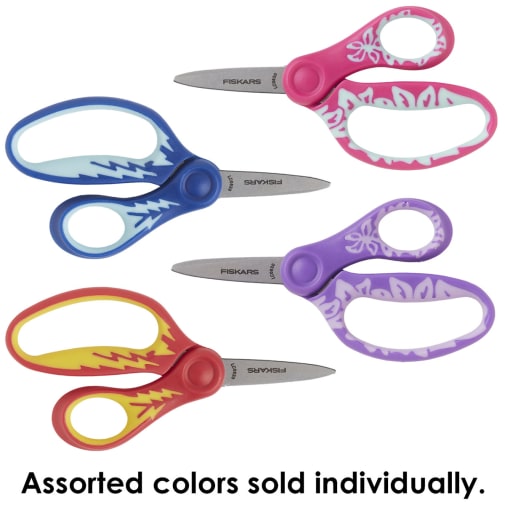Kids scissors are ideal for children grades PK-4 as the handle size is small, and the scissors feature a new safety edge blade that won't cut fingers but are sharp enough for cutting construction paper, felt, and foam.
Fiskars Kids Softgrip Scissors (pointed) Asst
SKU
035440
Grade 3-AD
These icons are designed to help you quickly understand and learn important information about our products.
Teaching Method
Traditional
Teacher-centered curriculum commonly used in classrooms that may include a text, teacher manual, tests, etc.
Charlotte Mason
A methodology based on the work of a 19th century educator who maintained that children learn best from literature (Living Books), not textbooks.
Classical
A methodology based on the Latin Trivium (three stages of learning), including the grammar stage (memorization and facts), logic stage (critical thinking), and rhetoric stage (developing/defending ideas).
Unit Study
A thematic or topical approach centered around one topic that integrates multiple subject areas.
Montessori (Discovery)
A methodology based on the work of a 20th century educator that emphasizes student and sensory-driven discovery learning and real-life applications.
Other
Other methodologies
Religious Content
Secular
Contains content contrary to common Christian beliefs (i.e. evolution).
Neutral
Avoids religious or theoretical topics or presents multiple viewpoints without preference.
Christian/Religious
Faith-based or including instructional religious content.
Learning Modality
Auditory
Learns through listening, talking out loud or reading out loud.
Visual
Learns through seeing, prefers written instructions and visual materials.
Kinesthetic/Tactile (Hands-On)
Learns through moving, doing and touching.
Multi-Sensory
Curriculum that employ a variety of activities/components.
Presentation
Sequential
Curriculum progresses through well-defined learning objectives. Emphasizes mastery before moving to the next topic.
Spiral
Topics and concepts are repeated from level to level, adding more depth at each pass and connecting with review.
Conceptual/Topical
Focus is on the “why,” often with a unifying concept as well as specific skills; coverage may be broader.
Teacher Involvement
Low Teacher Involvement
Student-led materials; parent acts as a facilitator.
Medium Teacher Involvement
A mix of teacher-led time and independent student work.
High Teacher Involvement
Teacher-led lessons; may utilize discussions, hands-on activities and working together.
Additional Materials Required
No other materials needed
Everything you need is included.
Other Materials Required
There are additional required resources that are a separate purchase.
Other Materials Optional
There are additional resources mentioned or recommended but are not absolutely necessary.
Consumable
Consumable
Designed to be written in; not reusable.
Non-Consumable
Not designed to be written in; reusable.
Our Price
$4.99 $4.99 $3.95
Rainbow Savings: $1.04
Description
Publisher's Description of Fiskars Kids Softgrip Scissors (pointed) Asst
Kids love the colorful, comfortable grip and the improved cutting control of the pointed-tip design.
Our Softgrip® Pointed-tip Kids Scissors give children a pair of scissors that's safe and comfortable to use with a blade tip design that offers excellent cutting control. Additionally, it features a creative, colorful handle that makes cutting fun for kids. Like all of our Kids Scissors, our Softgrip® Pointed-tip Kids Scissors feature innovative safety-edge blades for high-quality cutting with a safer blade angle.
- Ideal for kids ages four and up
- #1 teacher recommended brand
- Softgrip® handle provides more comfortable use for children
- Innovative safety-edge blades feature a safer blade angle to protect kids while still cutting all classroom materials
- Pointed-tip blades offer improved detail cutting
- Larger finger loop and an ergonomic thumb loop provide a natural, more comfortable fit for kids' fingers
- Antimicrobial handle protection inhibits the growth of bacterial odors and helps prevent product deterioration
- Accommodates right- and left-handed users
- Available in a range of colors
- Length: 5"
- Lifetime warranty
Category Description for Pointed-Tip Scissors
Available in blunt and pointed tip, with corrosion-resistant blades, these cut felt, fabric, ribbon, yarn, string, and paper cleanly to the tip.
Details
| Product Format: | Other |
|---|---|
| Grades: | 3-AD |
| Brand: | Fiskars |
| EAN/UPC: | 020335077447 |
| Length in Inches: | 6.875 |
| Width in Inches: | 3.375 |
| Height in Inches: | 0.5 |
| Weight in Pounds: | 0.05 |
Videos
Reviews

